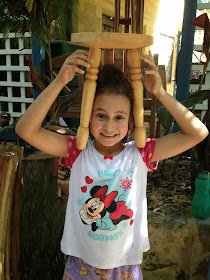 |
| Jacaranda mimosifolia. These flower across Perth in late Spring each year. |
 |
| The last part of the Jacaranda being pulled down by the excavator. |
 |
| The three turned Jacaranda legs, awaiting the stool top. |
When I made a stool last year for little Annabelle from her Cape Lilac tree, my grand daughter Paree requested a stool too. She liked the turned Jacaranda legs which I had hanging around, and announced that they should be part of her stool. I agreed and promised to make her a Jacaranda stool. Paree really likes the colour of the flowers on the Jacaranda trees.
 |
| Bevelling the underside of the seat with a spokeshave to reduce the thickness of the edge. |
With the top's edge and underside shaped, I carved Paree's name on the underside of the seat and then set out the leg positions.
 |
| Working out the angle of the legs... |
The angle found, (about 12 degrees) I set up the drill press to bore the three holes.
 |
| The angled holes were drilled with a drill-press. |
Funnily enough, I made the legs back in October, made the top in November, and completed the stool in February! Just as well Paree was patient ... though she did often remind me about her stool and ask me about progress!
 |
| The tenons were finish-turned to size on the spring pole lathe. |
The holes were drilled to 25mm with a spade bit, right through the top. The tenons on the legs were turned to about 25.5mm, and a tenon saw used to cut a kerf down into the end or each leg's tenon. These would take the wedges I prepared from some pieces of Cape Lilac.
 |
| Three Cape Lilac wedges were made for the tops of the legs. |
Good old Titebond III was used for the glue-up. The tenon surfaces and the inside of the holes were coated with glue, and the legs driven into the top. The wedges were then driven into the tops of the legs, to lock them in.
 |
| Legs driven into the seat, and wedges driven into the top ends of the legs. |
 |
| Lookin' good... the glue drying... |
When the glue had dried, I used a tenon saw to cut off the protrusions. A block plane was then used to plane the ends of the legs off flush. and clean up the seat top. Yes, I did then sand the top - not very traditional, like the drill press, but it all comes down to the limited time available! A trade-off.
 |
| Well, the top and legs were made in 2014 ... but it was February 2015 when I finally completed the stool! |
The next step was to level it up. The stool was stood on a flat surface, and the legs packed up until the measurement from the top to the flat surface was consistent (the top now parallel to the flat surface), and a pencil used to mark lines parallel to the flat surface, on the lowest common denominator principle. The legs were then cut to the pencil lines. The result? a level stool top with feet which sit nicely flat on the ground. Nice.
I then applied a couple of coats of Orange Oil. The following day I applied a couple of coats of a nice product consisting of Orange Oil, Beeswax, and Carbauba Wax. Lovely stuff.
l
 |
| Seat levelled, legs trimmed, and first coat of oil applied. |
In the pic above you can see the legs nicely flat and parallel to the seat.
 |
| Not a bad looking stool. |
There it is... the completed stool. It took a few months, but I was determined to deliver on my promise to my Granddaughter. I also had a lot of fun along the way.
Paree, the proud owner of her much awaited stool. Love you, Chook!
Considering the original size of the Jacaranda Tree, which was being demolished along with the house as the block was cleared, it is a shame I obtained so little of that tree. Imagine how many things could be made from such a tree. Every day dozens of huge trees in backyards all over Perth are being cut down and chipped up or carted off to land fill. Green woodworking provides a simple way of value adding this wonderful resource wihch we are wasting, with minimal gear.
Simple steps towards more sustainable living. Viva la revolution!


























